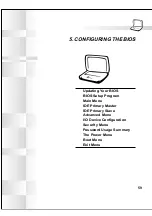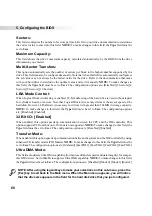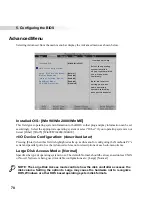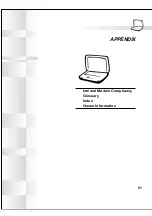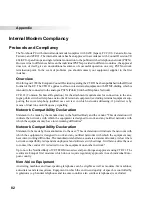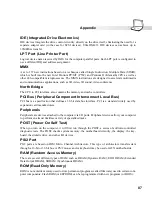
72
5. Configuring the BIOS
I/O Device Configuration (sub-menu)
I t e m S p e c i f i c H e l p
I / O D e v i c e C o n f i g u r a t i o n
I R P o r t
[ U s e r ]
B a s e I / O a d d r e s s :
[ 2 F 8 I R Q 3 ]
M o d e :
[ F I R ]
D M A c h a n n e l :
[ D M A 3 ]
C o n f i g u r e I R p o r t u s i n g
o p t i o n s :
A u t o
[ O S c o n f i g u r a t i o n ]
U s e r
[ U S E R c o n f i g u r a t i o n ]
D i s a b l e d
[ N O c o n f i g u r a t i o n ]
NOTE: The presence of sub-items in this menu is dependent on certain relevant set-
tings.
WARNING! Changing the default address and IRQ settings for COM1, COM2 and the
LPT Port can cause conflicts with other system devices or installed peripherals.
IR port: [User]
This field allows you to configure the Notebook PC’s serial IR port. The configuration options are:
[Disabled] [User] [Auto]
Base I/O address: (when User is selected in IR port)
When User is selected, the Base I/O address field allows you to set the serial port IRQ and I/O ad-
dresses. The configuration options are: [3F8 IRQ4] [2F8 IRQ3] [3E8 IRQ4] [2E8 IRQ3]
Mode: (when User is selected in IR port)
When User is selected, the Mode field allows you to select either Standard Infrared (SIR) or Fast
Infrared (FIR) communication mode. The configuration options are: [SIR] [FIR]
Summary of Contents for S82A
Page 5: ...5 CTR 21 Approval for Notebook PC with built in Modem Italian Portuguese Spanish Swedish ...
Page 13: ...13 Top Side Front Side Left Side Right Side Rear Side 2 KNOWING THE PARTS ...
Page 81: ...81 APPENDIX Internal Modem Compliancy Glossary Index Owner Information ...
Page 84: ...84 Appendix ...
Page 91: ...91 Appendix ...


